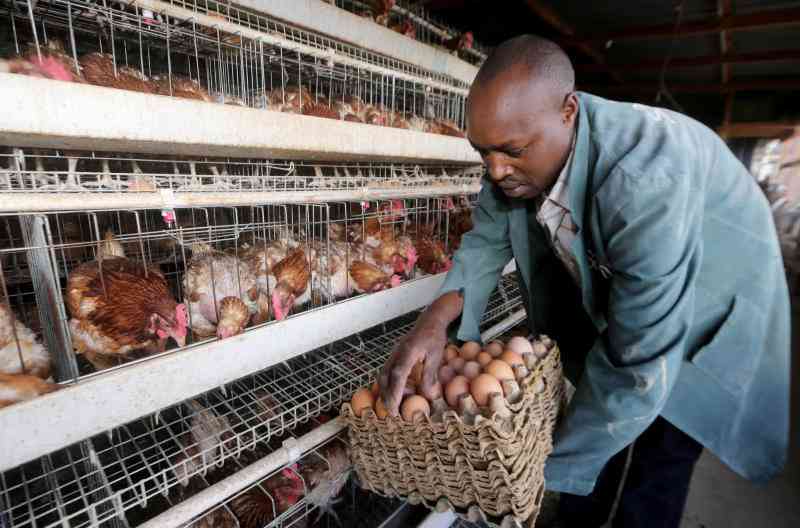“Hi Daktari, I started poultry rearing about three years ago.
I have been keeping both the kienyeji and the exotic breeds.
The greatest challenge I have faced is presence of poor quality feeds as well as counterfeit animal feeds in the market, which has resulted in great economic losses.
What can a small scale farmer like me do to avoid being a victim of such products? Mary Chege from Nakuru”. This was an email I received from one of the fervent Smart Harvest readers.
The availability of poor quality feed in the market is a challenge that most poultry farmers grapple with.
Unlike other livestock animals such as dairy cows that rely on different sources of feed for their dietary requirement, poultry especially commercially reared chicken solely depend on formulated feed which account for 100% of their nutritional needs.
For this mere reason, negative effects of poor quality feeds are more pronounced and inescapable in chicken than in any other livestock species.
Feed formulation is more than just mixing of raw materials- certain standards and procedures should be followed to ensure the final product meets required specifications and is homogeneously mixed.
Most feed millers in the country do not adhere to globally set feed manufacturing standards.
Very few companies are able to meet the set standards. Feed millers should ensure they use feed analysis laboratory services every time they produce a new batch of feeds.
Ideally all raw materials should be tested before mixing commences.
This is to make certain that the raw materials are of good quality and would provide the nutrients they are intended to and at the right proportion.
Other parameters e.g harmful elements such as aflatoxins found in cereals especially maize are also analysed- different harvests from the same maize farm would record different levels of aflatoxins, hence the need to analyse each and every raw material before formulating feeds.
The finished product should again be analysed to make sure it meets the intended specification for the particular type of feed.
Ideally feed miller should have an in-house lab to ensure that all these steps are followed through.
Unfortunately setting up of an in-house lab is quite costly and therefore these procedures are usually skipped.
Most of the time the millers out source lab services when a farmer forwards a quality related complaint and this may be already too late when damage has already been done.
Farmers who formulate their own feeds are also at a high risk of purchasing poor low quality raw materials and lab analysis of each and every single raw material may prove to be too costly for the farmer.
Farmers have also been exposed to unscrupulous millers who produce poor quality feeds for purposes of maximizing their profit margins.
Counterfeit feed in the market is also an issue that the government and feed manufacturing licensing bodies should address.
Fraudsters take advantage of popular feed brands and re-pack poor quality feeds in branded bags- similar to those of the popular feed companies.
Top feed manufacturing companies in the country are now using high quality, laminated (shiny) branded bags that are not easily faked.
The bags are almost tamper-proof and one can tell if a bag has been interfered with.
It is therefore advisable for poultry farmers to go for feeds in such tamper-proof bags.
A batch number, date of manufacture and contacts are usually provided with each bag.
Ensure each bag purchased contains this information and record of such should be kept.
In case of any complaints, the feed company may be contacted and the specific batch traced back.
Such steps would help minimize cases of counterfeit feeds in the market.
Feed stockists should ensure they source feeds directly from reputable distributors/ feed companies so as to eliminate the middle men.
Want to get latest farming tips and videos?
Join Us
 The Standard Group Plc is a multi-media organization
with investments in media platforms spanning newspaper print operations,
television, radio broadcasting, digital and online services. The Standard Group
is recognized as a leading multi-media house in Kenya with a key influence in
matters of national and international interest.
The Standard Group Plc is a multi-media organization
with investments in media platforms spanning newspaper print operations,
television, radio broadcasting, digital and online services. The Standard Group
is recognized as a leading multi-media house in Kenya with a key influence in
matters of national and international interest.
 The Standard Group Plc is a multi-media organization
with investments in media platforms spanning newspaper print operations,
television, radio broadcasting, digital and online services. The Standard Group
is recognized as a leading multi-media house in Kenya with a key influence in
matters of national and international interest.
The Standard Group Plc is a multi-media organization
with investments in media platforms spanning newspaper print operations,
television, radio broadcasting, digital and online services. The Standard Group
is recognized as a leading multi-media house in Kenya with a key influence in
matters of national and international interest.







